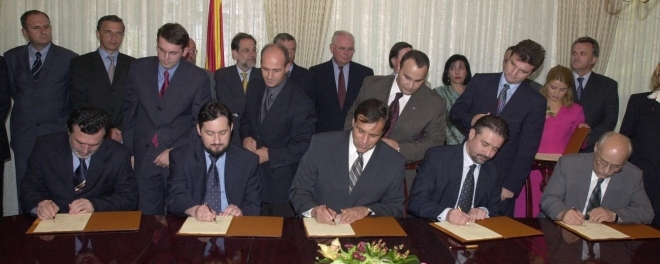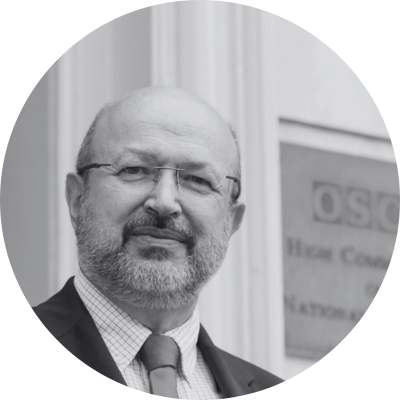
A CASE STUDY OF NORTH MACEDONIA’S NATIONAL ACTION PLAN ON WOMEN, PEACE AND SECURITY
INTRODUCTION: A GENDER-INSENSITIVE PEACE AGREEMENT
One of the successor states of the former Yugoslavia, the Republic of North Macedonia declared independence in September 1991 after a successful referendum. The first decade of independence was marked by the establishment of democratic institutions and practices. Steps were taken to build and reform different sectors. Then, in 2001, the relative peace between the different ethnic communities was disturbed by violent clashes erupting in several mountain villages. The ensuing armed conflict lasted for six months.
Women, particularly those active in the civil society sector that developed in the 1990s, were the first ones to take actions during this crisis, focusing on helping refugees and internally displaced persons, the majority of which were women and children. Women’s organizations helped to ease the impact of the conflict on civilians by providing psychological help, opening helplines, and delivering hygiene and food packages for children and women. During the 2001 conflict, these organizations built informal networks and alliances, which have remained active even after the conflict. That same year, a series of round tables were held and the Citizen’s Appeal for ending the armed conflict was issued. The aim of these actions was to show the importance of stabilizing the country and the commitments of women’s groups and civil society organizations (CSOs) towards maintaining peace and security.
The armed conflict ended with the Ohrid Framework Agreement (OFA) signed on August 13, 2001. The OFA became the key instrument for maintaining the inter-ethnic harmony in the country. Yet, the agreement does not mention the role and importance of women, their crucial involvement in conflict prevention and also post-conflict reconstruction. The body of the OFA included the principles of non-discrimination and equitable representation of different ethnic communities in the military and in the police forces, but the equitable representation of women was not addressed. Human rights trainings were part of the assistance programmes for police officers; however, gender equality trainings were not explicitly mentioned. The document also referred to the return and rehabilitation of refugees, but gender lenses were not applied. Overall, the content of the OFA lacked a gender perspective, because it did not take into consideration the specific and different needs of women and girls.
The Ohrid Framework Agreement became the key instrument for maintaining the inter-ethnic harmony in [Macedonia]. Yet, the agreement does not mention the role and importance of women, their crucial involvement in conflict prevention and also post-conflict reconstruction.
No female expert was included in any of the three teams involved in the negotiation and mediation processes preceding the signature of the OFA. Four male representatives, one from each of the four main political parties, took part. Men also represented the international community and dialogue facilitators. Women may have participated in advisory or supportive positions in the teams. However, in terms of women’s visibility during the negotiation process and at the OFA signature ceremony, women remained once again invisible.
______
FROM UNSCR 1325 TO MACEDONIA’S FIRST NATIONAL ACTION PLAN
Officially adopted in 2000, UN Security Council Resolution (UNSCR) 1325 represented from the very beginning a key document to support the integration of a gender perspective within the peace and security field, underlining the role of women and the importance of women’s inclusion in preventing and resolving conflicts, as well as in peacebuilding. Relying on UNSCR 1325, women’s organizations, which had played a key role in the anti-war movement, also started to make significant contributions to building peace, reconciliation and improving inter-ethnic relations in Macedonia. Three years after the conflict ended, in 2004, one of the first projects within the peace and security agenda was implemented by the Women’s Civic Initiative Antico, an inter-ethnic network of Macedonian women leaders. Antico advocated for the inclusion of the strategic goal “Women, Peace and Security” within the first National Action Plan for Gender Equality, in 2007. In 2009, another civil society network, the National Council for Gender Equality, launched a project entitled “1325 Reasons for Implementation of Resolution 1325,” aimed at promoting a culture of peace and advocating for the development of the first National Action Plan (NAP) for the UNSCR 1325. And in 2012, the Organization of Women of Sveti Nikole, a women-led civil society organization, conducted a research about the level of awareness and knowledge about UNSCR 1325 among different stakeholders. It was alarming that a significant percentage of the respondents did not recognize the link between women’s rights and the peace and security agenda. The data also showed that only a small percentage of the general public was familiar with the UNSCR 1325. On the other hand, a high percentage of the respondents considered that it was necessary to prepare a NAP.
Relying on UNSCR 1325, women’s organizations, which had played a key role in the anti-war movement, also started to make significant contributions to building peace, reconciliation and improving inter-ethnic relations in Macedonia.
All these activities paved the way for the NAP developed in 2012. In February of that year, a working group for the preparation of the first NAP on Women, Peace and Security was established. It comprised representatives from all relevant institutions, including the Ministry of Labor and Social Policy, the Ministry of Defense, the Crisis Management Center, the Ministry of Foreign Affairs, as well as representatives of three women’s organizations and of international organizations.
The first NAP was officially adopted in January 2013, at the request by the Ministry of Labour and Social Policy, supported by the Ministry of Defense. Both institutions signed a memorandum of cooperation for the adoption of the NAP. Prior to its adoption, the Assembly’s Commission for Equal Opportunities also organized public debates, developing consultative and participatory processes to ascertain the contents of the document. The NAP covered a three-year period (2013-2015) and contained one-year operational plans for implementation. It foresaw three strategic goals:
- Strengthening the gender perspective in the implementation of the peace, security and defense policy;
- Increasing the participation and contribution of women in international, civilian and military missions;
- Preventing violence and protecting women’s rights in the time of peace, conflict and humanitarian crises.
Three general indicators were also set up: first, content analysis of key political documents on representation, type and frequency of terms related to gender equality; secondly, tracking the number of applications and appointments of women in international civil and peacekeeping missions; and lastly, strengthened prevention of violence against women and girls and improved mechanisms for gender-sensitive risks assessment of natural disasters.
The positive side is that, through preventive and municipal councils, the NAP promoted the active role of women in conflict prevention, community recovery, emergencies, and crisis management. It recognized the need to increase the participation of women in peacekeeping and humanitarian missions and acknowledged the gender-based risk assessment of natural disasters, humanitarian crisis, and catastrophes.
On the negative side, however, while the NAP identified an inter-ministerial working group for monitoring the implementation, it did not provide a clear reporting mechanism. It did not include specific information about the frequency of the working group’s meetings, and it did not mention monitoring by CSOs. Progress on the indicators is not known since there has been no report about the implementation of the NAP. Some of the results within the list of “Expected Results” are vague and unmeasurable. The NAP is unique in explicitly stating that “activities envisaged in the NAP shall not have any financial implications” and that the responsible institutions will need to use their own available budgets. Overall, the financial concern over budgeting has been one of the greatest implementation challenges.
______
CONCLUSION: TOWARDS A SECOND NAP
Macedonia’s first NAP lacked an intersectional approach and failed to address the heterogeneity and multiplicity of women’s experiences despite the involvement of three multiethnic women’s networks. The plan’s focus is on gender, but the other variables that intersect with gender, such as ethnicity, religion, age, sexual orientation and disability are not included. It refers to women as a homogenous group and does not address the different categories of women who are differently impacted by conflict, insecurity, and peacebuilding. Having in mind that the country, as all countries in the region, is prone to the phenomena of violent extremism, the link between the WPS Agenda and the role of women in preventing and combating violent extremism is missing.
Furthermore, while a new NAP should have been adopted after 2015, this has not yet happened. The time frame for the preparation of the new NAP has, in fact, been breached, and the country has now been without a new NAP for 5 years. In January 2020, an inter-ministerial working group was again formed for the preparation of the second NAP. The group is led and coordinated by the Ministry of Defense and is due to meet in the next few months to work intensively on the adoption of this important document.
In conclusion, from 2000 up to now, a great number of women-led organizations have implemented activities related to improving the visibility of UNSCR 1325, the localization of the NAP and its importance for the WPS Agenda. Progress has been made in tackling lack of inclusion of women and women-led organizations, but there is much work that needs to be done. Since a good NAP represents a strategic roadmap to further the implementation of the Macedonian state’s WPS Agenda, a few critical aspects need to be included in the new NAP: first, sufficient funding needs to be provided for the implementation; clear monitoring and evaluation systems need to be set up; a coordinated and clear strategy needs to be developed for collaboration with all relevant stakeholders; an intersectional approach needs to be established in addressing gender equality; and, finally, the WPS and countering violent extremism agendas need to be integrated.
______
Daniela Antonovska is a gender equality expert and consultant.
This article was published under the aegis of the Enhancing Women’s Participation in Peace and Security (WEPPS) project, whose goal is to strengthen the effectiveness and impact of the WPS Agenda in Italy, North Africa and the Western Balkans. The WEPPS project is being implemented by the ERIS group (Emerging Research in International Security) of the Scuola Superiore Sant’Anna in Pisa, Italy, in partnership with the Agency for Peacebuilding. It is funded by the Italian Ministry of Foreign Affairs and International Cooperation.































